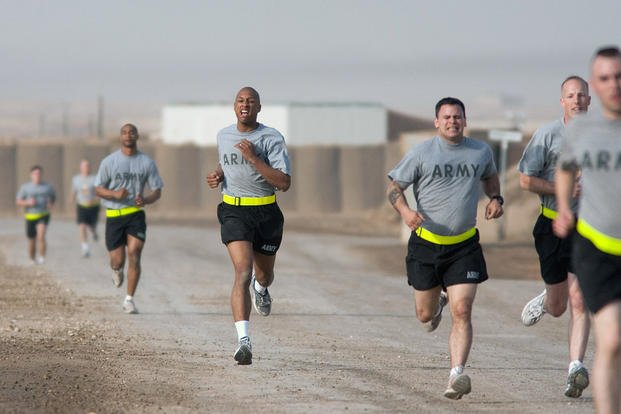People use many types of running workouts to improve their pace for timed runs and longer-distance races. Knowing which ones are best for you and how to place them into your week is a mix of best practices and personal preferences.
Testing different running workouts for a few months and checking performance is the short answer to the following question about options to improve speed and pace for military fitness test timed runs:
Stew, what is the difference between a Fartlek run, goal pace run, or tempo run, and should I consider adding them to my running week? Thanks, Kristan
Kristan, that's a great question. Practicing running faster for specific periods or distances is key to improving your pace. Whether you are preparing for a 1.5-mile timed run (Navy, Air Force, Coast Guard), a 2-mile timed run (Army), a 3-mile timed run (Marine Corps), or longer distances (such as the 4-mile timed run at SEAL Training or the 5-mile timed run at Army Special Forces and Ranger testing), all can be improved by a combination of running workouts throughout the week. Changing your running workouts each day will break up the monotony, force you to run faster some days, and help you learn the pace you need to reach your goals.
To answer your question more specifically, here are the types of run workouts you asked about:
Fartlek: The term is Swedish, meaning "speed play," and generally refers to workouts in which you run fast and then jog slowly for a variety of set times and distances. We typically do these on a track and go fast from 100 to 400 meters, then the same distance jogging slowly to recover. If you need to walk, you can, but the goal is to recover with a slow jog. These differ from intervals mainly due to the rest periods, as intervals are full sprints followed by a walking/recovery period.
Goal pace running: Similar to interval running, but instead of running a sprint at full speed, you dial it down to the goal mile pace you are trying to master on the next timed run. For instance, if you run a 7-minute mile for the 1.5-mile timed run (10:30), you can set up your workouts to improve that to a 6-minute or 6:30 mile pace by making your intervals at that pace.
An example of this is:
- Run 400 meters at goal pace (1:30-1:35)
- Walk 100 meters
- Repeat the above two segments for a total of six times
This time of 1:30-1:35 for the 400 meter is the pace to put your timed run into the 6-6:30 mile pace zone. The goal is not to run faster or slower than that, but to master the exact time for multiple sets for at least the distance of your timed run event (6 x 400m=1.5-mile run). I like to practice goal pace two or three times a week if I run four to six times weekly. The other runs can be a mix of Fartlek, tempo and intervals. You can even use a form of intervals with goal-paced running: Instead of a sprint, do a goal pace set and rest with an easy walk (or jog).
Tempo running: This medium-intensity type of workout is similar to goal-paced but for longer intervals (usually a time vs. a distance set). These typically go for 20-40 minutes at an intensity that is not a sprint, but at or flirting with your goal pace. This is a challenging run but doable, with no rest for that duration. If you compare sprinting at 100% effort, the tempo run is more of a 60-75% effort.
Placing these three workouts into your week can be fun and offer variety. If working to improve timed runs, I would focus on the following schedule:
- Monday / Wednesday / Friday: Goal pace running. You must learn pace; practice it often.
- Tuesday / Thursday: Fartleks or interval workouts to work at speed. Mix in some leg calisthenics to top off a great leg day blended with difficult running workouts. Many just do one of these a week and replace the second one with a day off from running or a less intense day of running or non-impact cardio.
- Saturday: Consider a tempo run if you have the energy, or a slow distance run. If you feel you have hit your limit due to the impact of running, consider a "long slow distance" type of aerobic base workout with a bike, rowing machine or swimming laps. Many non-running athletes should consider this option as they start to progress into higher running miles per week to avoid overuse injuries.
There are many ways to arrange a week of running, but all have to adhere to a logical progression of total miles per week so you do not injure your feet, shins and knees. For a standard progression, whatever the distance of running you are doing now, arrange the workouts as you prefer, but add only 10-15 % of the total distance each week.
Want to Learn More About Military Life?
Whether you're thinking of joining the military, looking for fitness and basic training tips, or keeping up with military life and benefits, Military.com has you covered. Subscribe to Military.com to have military news, updates and resources delivered directly to your inbox.


















